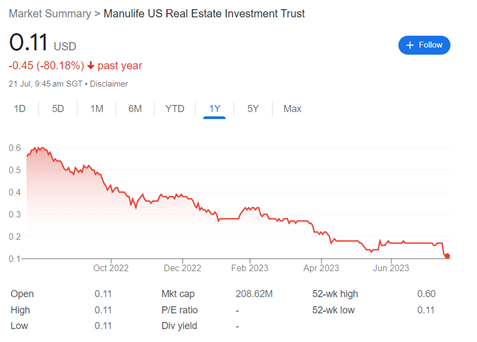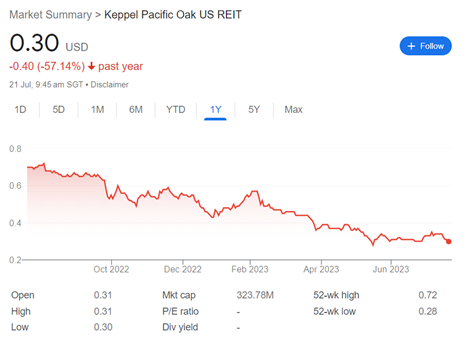Commercial Real Estate is no doubt in a dire situation. Occupancy has continually declined across the U.S. office market due to a slowdown in demand and leasing activity. Higher vacancy levels results in landlords having to increase leasing incentives to attract new tenants or retain tenants, giving rise to higher leasing costs and lowered profits.
The Fed has raised interest rates from 0% to 5% in less than 2 years and analysts are pointing to one final hike to 5.25%. Higher interest rates lead to higher borrowings costs, further lowering profits.
From a valuation perspective, the higher risk free rate leads to higher discount rates and terminal capitalisation rates, pushing asset valuation lower.
In addition, the risks posed by the slowing macroeconomic environment as well as the work from home trend has led to certain submarkets being weaker than others.
Commercial real estate prices are in a crisis state. In June 2023, there was a sale of an office tower at One South Street in downtown Baltimore for $24 million, a 63.6% discount versus the previous 2015 sale of $66 million. Arguably, this could be an isolated case as declines in quality assets have also been significant but not as drastic. Nevertheless, the decline is shocking.
Another example of the dire situation worldwide is in Australia where major Australian REITs have limited withdrawals from its unlisted office funds. Investors in an unlisted A$2.5 billion fund with the Charter Hall Group received only 25% of the amount they requested to withdraw during its once every five year withdrawal window.
Looking closer to home, Manulife REIT (MUST), Prime REIT (Prime) and Keppel Pacific Oak US REIT (KORE) have recorded one year share price declines of 57% to 80%. Even factoring in dividends, total losses are still very significant.



Here we try to analyse whether you should buy, hold or sell any or all of these three REITs.
Although the situation for each of the three SREITs are very different, Fundamentally, all three REITs are in the same boat from a macroeconomic standpoint.
Let’s take a look at each of the potential decisions you could make as a shareholder:
1) Buy the dip – Cheap is good
The Commercial Real Estate sector has fallen significantly and is now viewed as distressed. There are opportunities to purchase assets with potential. Buyers are limited because of the current funding cost.
For MUST, Prime and KORE, one may take the view that the bottom is in or close by. As long as the REITs do not default on their financing obligations or breach covenants, they would be able to tide through these times.
Investors may not have to take a long term outlook as a small change in sentiments enabled by a peak in interest rates or even rate cuts coupled with a back to office trend may lead to share prices doubling and running ahead of fundamentals in the near term. A few analysts are cognizant of this possibility and have provided buy calls with such views.
With the backing of able sponsors, these REITs may have the ability to pick up distressed assets for cheap, realise the asset’s potential through asset enhancements and improve occupancy rates by leveraging on the sponsor’s network or even by leasing to the sponsor itself who could be in a growth phase.
2) Hold on for dear life
Before we get into the details – an advance warning to holders to prepare for equity fund raising situations.
Surviving requires risk management. This means that REIT managers are on the look out to refinance their borrowings, push out obligations and even negotiate a relaxation of covenants. To mitigate against the inability to refinance, REITs may even sell assets to repay these borrowings ahead of time.
To further strengthen the balance sheet and tide them through, they may even look to raise equity. There is no knowing how much each REIT will look to raise but most REITs who face pressures will look to reduce their gearing ratio to at least 45% and below.
This means that current distributions per unit (DPU) may not be indicative of the future DPU after survival actions are taken and there is a strong possibility that DPU would be much lower than the present.
For MUST, Prime and KORE, one may take the view that the REIT managers are taking action and that the bottom is in or near. As long as the REITs do not default on their financing obligations or breach covenants, they would be able to tide through these times.
3) Sell and move on – can’t be saved
Sometimes the circumstances are so dire that even by taking proactive measures, it may not be adequate to survive.
It is not enough for the REIT to succeed in refinancing all current debt and even debt that may only be due in more than one year if there are existing covenants and limits in place such as interest coverage and gearing ratios. These covenants and limits can be breached or exceeded if profits and asset values plummet.
For MUST, we would sell and move on. With a gearing of 57%, it cannot incur additional borrowings, and this will severely handicap the REIT. It also seems to be handicapped by a lack of support, no doubt in part due to the various red tapes as a listed US S-REIT.
MUST is also considering holding back capital expenditure to conserve its cash. This may reduce the competitiveness of its assets and result in further value decline as tenants either move to higher quality assets or demand lower rental rates.
For Prime and KORE, clearly, they are not in the same situation, but as time goes by, it is anyone’s guess as to whether Prime and KORE will fall into the same situation as MUST.
Should you Buy, Hold or Sell?
Much like any other distressed situation investing, valuations always seem very attractive. In many cases it ends up as too good to be true.
The two questions to answer are:
- Is the risk systemic or idiosyncratic? – if the risk is idiosyncratic, it is best to avoid unless you have certain unique insights.
- Where the risk is systemic, can the risk be resolved over time? – In this case, we believe that there is a chance that the economy improves over time and interest rates will be reduced as inflation abates.
In the case of a REIT, unless it is sufficiently diversified, it may face too many idiosyncratic risks.
Hence, we will probably choose to not buy the dip.
Whether it is sensible to hold or sell will depend largely on personal portfolio allocation and other personal considerations.

Free cash flow of KORE increased.
So what’s your final verdict ?
Not too clear on your conclusions
Will be helpful if you can give your personal opinion with caveats
not not buy now until Sep 2023, whether interest hike or maintain
Good analysis. Don’t buy REIT just because of high yield. Learn to understand the fundamentals before entry. Thanks to author for sharing!